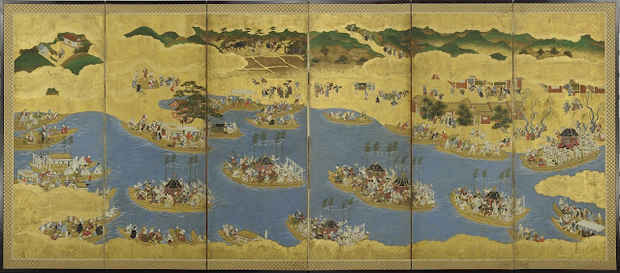"Edo to Video: Japanese Screens" Exhibition
Dillon Gallery

This event has ended.
Dillon Gallery presents a survey on the development of screen making from the Edo period through digital technology and video making of the 21st century. In an effort to show the comparative and disparate styles of screen making and the contemporary applications currently in use, this exhibition brings together an elegant variety of techniques. Beginning with two remarkable Edo period 6 fold narrative screens from the Hie Sanno Matsuri festival , the works are of unknown origin dating from the 16th and early 17th century and form the starting point of the exhibition.
Edo - Video is comprised of 9 artists that have continued with this specific genre. The earliest works display the traditional festival that took place every April, when large portable shrines were loaded on to boats and taken back to the village. The visual esthetics are echoed in the work of Masatake Kouzaki , a contemporary Japanese artist that employs the traditional techniques and clouds of gold used in the Edo period, to portray a very different world of satellites, space ships and genetically engineered animals. Keizaboro Okamura has interpreted the Edo period screens using monumental burnt wooden hinged structures, depicting mythological Japanese sea creatures. Norihiko Saito, a mid-career master of shoji screen making, has created a small treasure of the sakura (cherry blossom) in its most abstracted state. The further use of abstraction in the screen making process is highlighted by a work painted by Makoto Fujimura, titled “Emily Dickenson’s trinity”. Using Belgium linen, instead of the shoji screen, he applies pigment and gold leaf directly to the linen, and his pigments are applied in the quick motion of action painting- alongside the delicate application of gold leaf spheres. Further stretching the category, Yuzo Ono has defined the limits of the application of the pigments to a simple aluminum screen and a reductive technique of malachite pigments. Yuji Sasaki the famous landscape artist has sought his own style of abstract landscape with his skilled techniques and vivid colors providing a visual Haiku translated into a mini screen. Kazuyuki Futagawa has provided a master screen, “ Blue Green trees “, keeping closely to the prescribed technical aspects of a Japanese screen by using “Iwaenogu” – Japanese mineral pigments. The final inclusion of the video work of Mami Kosemura “Flowering plants” a technical masterful 3 part video installation, based on antique Japanese screen imagery, guide the viewer towards the final frontier of screen making’ the moving image.
Media
Schedule
from April 12, 2012 to May 26, 2012
Opening Reception on 2012-04-12 from 18:00 to 20:00
Artist(s)
Makoto Fujimura, Mami Kosemura, Norihiko Saito, Keizaburo Okamura, Masatake Kouzaki, Yuzo Ono, Yuji Sasaki, Kazuyuki Futagawa et al.